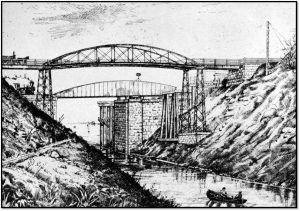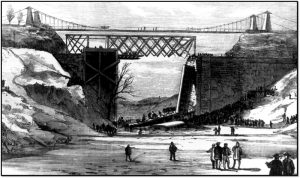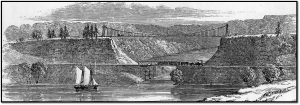Squire Whipple built two wooden swing bridges in Ontario, Canada, in 1853 on the Great Western Railway. One was near Hamilton, Ontario, at Dundas and the other over the Welland Canal at Thorold Station just west of Niagara Falls. The bridge at Hamilton, called the Desjardins Bridge, opened in early November 1853. The turntable was on the bank and not in the center of the bridge as was generally the case. Large masonry abutments had been built to cut down the length of the swing span required. In addition, a wooden structure was built, upon which the swing span rested when it was in an open position. The waterway was 66 feet wide and required a swing span of eighty feet (from the center of turntable to the far abutment) to reach the other side of the channel.
The counterweight span was 36 feet (44 feet from the center of the turntable) making the entire span 124 feet, including the 16-foot-diameter turntable panel. The truss pattern had tension ties and counters in each panel and no verticals. The truss height was 18 feet with the truss members on the small side for contemporary structures. Whipple wrote in his 1869 appendix to his 1847 book, A Work Bridge Building …for Iron and Wooden Bridges:
After being used nearly 3½ years, and borne the passage of, probably, 10,000 trains, and passed through vicissitudes testing its capacities pretty thoroughly, including the swamping of a heavily loaded freight car, which broke loose upon a steep grade and ran on to the bridge (off of the track) with such speed and force as to break 6 or 8 beams; on the 12th of March, 1857, it met with a disaster involving consequences most lamentably fatal.
On that day, the Locomotive Oxford, drawing a passenger train eastward, with a broken axle, ran off the track upon the downgrade approaching the bridge and could not be stopped till it went crashing into the timber of the bridge; probably coming in collision with the light lattice timbers on the right hand side, cutting them off, and letting the engine and train down some 40 feet into the canal.
Such was the conclusion arrived at by the Coroners’ Jury, after a long and thorough investigation and the hearing of a vast amount of testimony by experts and others. The Jury also found that the Bridge was “safe and sufficient” for the traffic of the Road, with engines & trains upon the Track; but not sufficient, in case of their running off the track while passing over the bridge.
The bridge had never been supposed to be safe for the passage of trains off the track, and it is believed that few bridges in the country would be reliable in such conditions. There was, however, a general concurrence of opinion, in the testimony at the Inquest, that the bridge would have borne, before straining the materials to their utmost capacity, from 3 to 5 times the weight that would ever come upon it in ordinary usage.
There was another bridge of the same kind, and built at the same time, for crossing the Welland Canal at the Thorold Station, upon the same road; and the length of time the structure sustained the heavy traffic of that road should be regarded as a demonstration of the adaptability of this Plan of Bridging to railroad purposes.
It was still winter in Canada West; the canal was not operating, and the bridge was “spiked” closed and acted like a fixed span rather than a swing bridge. Newspaper accounts of that fateful day of March 12, 1857, told of the disaster, with one giving the following description of the events occurring as the 4:10 P.M. train out of Toronto reached the bridge,
We have said that the train had passed the switch apparently all right; in a moment or two, the locomotive enters on the bridge; one sharp, shrill whistle gives the only warning to the passengers that between them and eternity there is left scarcely sufficient time to say, “May the Lord be merciful!” The Oxford sinks through the floor of the bridge, and goes down, with that brave driver BURNFIELD, who perished at his post, in the execution of his duty. Next comes the tender, and then the baggage car, in which there were two or three persons. And then the first passenger car, with its fifty precious souls, comes down the rails and takes the fatal leap, either turning a complete somersault or careening over upside down. It lies across the bed of the canal, the ice being broken through, and the car is about half filled with water. But there is yet another car-load of mortal beings poised for a moment on the top of the wall, and then it, too, plunges into that fearful abyss leaving the hind trucks on the rails above a poor remnant of a whole train, which but a moment before was as perfect as skill could make it, and bore homeward many a manly heart and fondly-beloved father, mother, husband, wife, brother, sister and child. A few escaped, and others perished in the attempt; but not less than fifty-seven or sixty lives were, “at one fell swoop,” cut off in the twinkling of an eye, as it were, and souls were landed on the shores of eternity which had no time to reflect of its grandeur or its despair.
The news of the disaster spread rapidly throughout the United States and Canada, and even abroad. In its April 14, 1857 issue, the Illustrated London News ran a major article of the disaster entitled “Frightful Railroad Accident in Canada.” It quoted the Rochester Union of March 13, “the bridge appears to be a frail structure, to be thus easily destroyed.”
That everyone was not happy with the coming of the railroad was evident in an editorial in the Chatham Western Planet writing about this disaster and the previous wreck that had taken place near their city, which said,
Better, infinitely better, that the whistle of the locomotive had never woke the echoes of our forest than that it should have sounded the death knell of so many human beings who have dyed this road with their blood.
The jury for the coroner’s inquest was sworn in the day after the accident in the boardroom of the Great Western Railway. During the first three days of the inquest, testimony was given by people who had survived the crash or had witnessed the failure. They all said that they had always thought the bridge to be safe.
Richard Bond reported he had, “been connected with railways for 20 years; consider myself able to judge when a bridge is right or wrong; examined the bridge about a fortnight or three weeks before the accident; it was all right; always considered the bridge a safe one, and am aware of no report ever having been made that the bridge was not safe.”

Later view of the site with iron swing span on the same abutments replacing Whipple’s Bridge and a Whipple Truss on high piers replacing the suspension bridge.
On March 25, the Jury went to Thorold to inspect Whipple’s other swing bridge. The big day for Whipple came on the ninth day of the Inquest, March 26, when he gave his testimony in the case. He gave a lengthy statement describing his design methods and concluded,
From what proceeds, it is abundantly evident to me that the bridge over the Desjardin Canal was not broken down by the simple pressure of the traffic passing over it bearing fairly on the track rails; and it is my decided opinion from the examination I have made, and the facts and appearance I have witnessed since my arrival at the bridge on the 20th instant, that the immediate cause of the disaster on the 12th instant, was the violent collision of some part or parts of the locomotive attached to the ill-fated train with the timber of the ill-fated bridge either directly or through the medium of some interposed body.
The inquest continued for another six days with other men testifying. Thomas Keefer, a civil engineer of some renown and later President of ASCE, was one of the last to testify. He stated, “if I am correct in my belief of the immediate cause of its destruction on the 12th March, any wooden bridge with the roadway upon the lower chord would have shared a similar fate.”
On Tuesday, April 8, 1857, the Jury handed down its findings that, in part, were as follows:
The jurors aforesaid find that the immediate cause of the accident was owing to the breaking of the forward axle of the engine-truck close to the wheel on the right, at a point on the road not ascertained, in consequence of which the left forward wheel of the truck left the rail at or near the switch near the bridge, causing the locomotive when entering on the bridge to diverge to the right crushing and tearing away its supports, and precipitating the whole train into the canal, and resulting in the calamity which forms the subject of this melancholy inquiry…
The jurors aforesaid also find that the said bridge over the Desjardin canal was built of wood, and constructed of sufficient strength for the conveyance of the traffic of the line safely and securely over the said bridge, provided that the locomotive and cars remained on the railway track, but that the said bridge was not built of sufficient strength to sustain an engine and train in case they should run off the track while passing over the said bridge.
The jurors are of the opinion that the only certain way of providing against a similar catastrophe, at the same place, would be the erection of a permanent bridge, and they would, therefore, strongly urge on the Government to cause the same to be built forthwith, and also that the Toronto and Great Western lines should have separate tracks over said structure, thereby doing away with switches, which are always objectionable in such places.
The jurors would further recommend the renewal of the former law, compelling trains to come to a dead stop before passing on this and all similar bridges, believing as they do, that the lamentable accident might have been avoided had this precautionary measure remained in full force.
Whipple was completely exonerated of any wrongdoing or responsibility for the failure. As he said, he had never designed the bridge to handle trains off the track. With the death of 59 people, however, many questioned the ability of engineers to design safe bridges. The failure was attributed more to an operational problem than an engineering design problem.■


